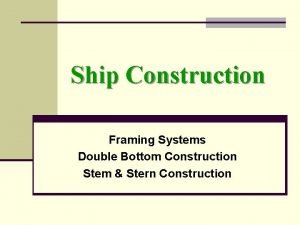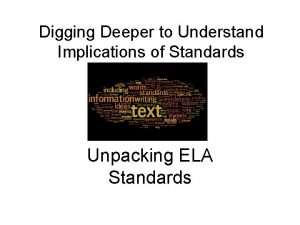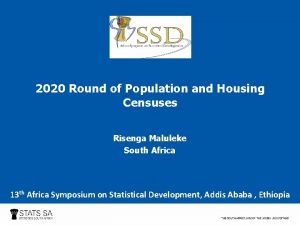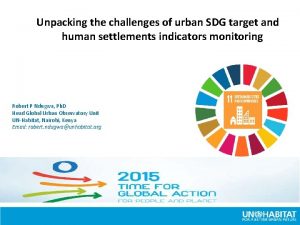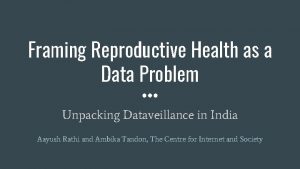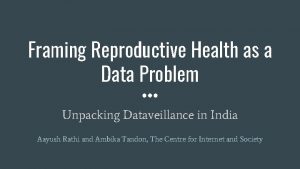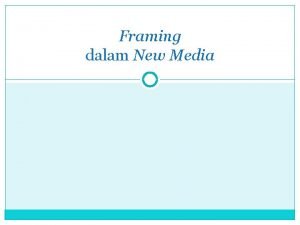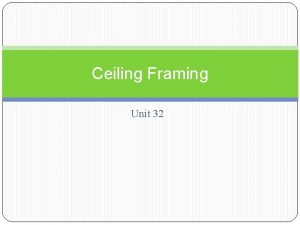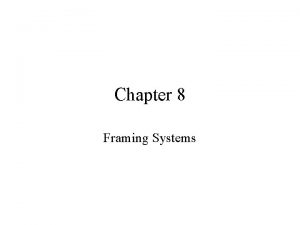NEXUS framing unpacking operationalising the nexus Model training




























- Slides: 28

NEXUS – framing, unpacking, operationalising the nexus Model training tool For DCA staff and partners 2020

Presentation outline • SESSION 1: FRAMING NEXUS (key policy agendas) • SESSION 2: UNPACKING NEXUS (internal and external barriers and drivers) • SESSION 3: OPERATIONALISING NEXUS (tools and guidance)

Outcomes • Strengthen common understanding of humanitarian- development-peace (HDP) nexus • Support DCA teams and partners in strengthening joint approaches and integration of activities • Understand barriers and drivers for HDP nexus programming to take effect

Session 1 FRAMING NEXUS Clarification on Nexus (what, why, where)

Framing nexus From Latin, ‘a binding together’ A relationship or connection between people or things A nexus is a central point

A historical perspective on HDP nexus • From Linking Relief, Rehabilitation, Development (LRRD) in the 1990 s, to Resilience in the ‘ 00 s to Nexus in ‘ 10 s • Protracted crisis is the new norm • 65 mill forcibly displaced by conflict, 130 mill people relying on humanitarian assistance • Protracted crisis in average last 7 years • Sustainable Development Goals • A big humanitarian finance gap which led to the first World Humanitarian Summit in 2016

From LRRD to triple nexus: what’s different? • A shift in focus away from how ‘we’ organise ‘our’ aid, and towards the lives of people suffering from crises. Remember people don’t have triple lives. • Focus on linking conflict prevention, resilience and coping mechanisms to peace and private sector

From LRRD to triple nexus: what’s different? Before: Little or no organizational restructuring, adjustments to funding streams or changes in roles of program (and support) staff. Lack of clarity of concepts, tools and little organisational impact. Now: more far-reaching organizational structures for implementation than previously (UN NWOW, CRRF, ECHO HIP, EU trust funds, etc. ). Strong commitment for collective outcomes by WB, UN, EU and donor states, NGOs SGD’s vision to leave no one behind

Grand Bargain nexus focus • Hum-dev-peace actors to align more effectively around collective outcomes towards achieving the Sustainable Development Goals. • Linking prevention, early action and long term recovery and peace • Focus on durable solutions for refugees and migrants • Strenthening national and local systems, actors and coping mechanisms for improved resilience (localisation) • Joint multi-hazard risk and vulnerability analysis, and multi-year planning

Nexus in the UN system – confused…?

NGO’s nexus focus • Lacking a coherent voice • Ad hoc organisational approaches to address nexus (by CARE, OXFAM, IRC, DCA, etc. ) • Localisation forms a key guiding principle for most INGOs, incl. community-led crisis response • A gap in documented, systematic learning and piloting around nexus approaches

Session 2 UNPACKING NEXUS § How to operationalize nexus and translate the concept into a DCA context? § External and internal barriers and drivers for nexus to take effect

How to operationalise nexus • Promote, as early in the planning of a response, coherent ways of working that are more effective and efficient in reducing risks, addressing vulnerabilities and needs, and building selfreliance • Strengthen operational links between hum-devpeace partners and activities to deliver collective outcomes for improved resilience of people

Nexus building blocks OECD: • Prioritise prevention, mediation and peacebuilding, investing in development whenever possible, while ensuring immediate humanitarian needs continue to be met, • Put people at the centre, tackling exclusion and promoting gender equality • Ensure that activities do no harm, are conflict sensitive to avoid unintended negative consequences and maximise positive effects across humanitarian, development and peace actions • Align joined-up programming with the risk environment • Strengthen national and local capacities, • Invest in learning and evidence across humanitarian, development and peace actions

In practice • Development actors should be present during crises to support resilience and the transition to development from the early stages of the crisis. • Humanitarian actors should plan for long term solutions from the earliest start of the crisis – in respect of humanitarian principles.

What it requires… • A common vision and cultural changes in organisations (donors, I/LNGOs, UN alike) • New ways of working to systematically foster complementarity, synergies and cooperation between humanitarian, development and other relevant actors and activities • Multi-year planning/funding and flexible funding streams

Nexus within DCA

Nexus within DCA strategic thinking Community-led crisis response Grand Bargain Resilience Refugee Response Framework Localisation Rights based approach Faith Based Organisations

HDP nexus

Internal drivers and barriers What are the key internal drivers and barriers within our own way of working and how do we achieve collective outcomes for the benefit of people and ensure long term sustainability in our humanitarian response?

Key barriers from DCA operation • How to engage the most vulnerable people – leaving no one behind (enabling people-centred approaches, vulnerability and capacity assessment, etc. ) • Balance quality with quantity • Creating synergies between different projects and teams • Securing (long term) funding for programming and staff • Enhancing learning and sharing culture across DCA and partners • Language barriers, ethnic diversity • Culture of aid dependency among some right holders • Incluencing authorities on key community priorities

Session 3 OPERATIONALISING NEXUS Activity 5: Solutions to barriers Activity 6: Develop an action plan Activity 7: Workshop closure and evaluation

Exercise 5: solutions to barriers Revisit the external and internal barriers. In groups, identify solutions to barriers and how you translate barriers into drivers

A nexus action plan

Follow-up after the workshop DCA facilitators will follow up: • Summarise your inputs in a workshop report and share it with you and DCA HQ • Will develop case study on nexus programming in DCA in Uganda • Use inputs for further development of nexus planning and tools development in DCA

Follow-up after the workshop DCA in-country staff will follow up: • Implement action plan • Review and adjust projects according to reflections from the workshop • Use outputs from the workshop in the project planning for next year

Closure and Evaluation Activity 12: Workshop closure and evaluation • Final comments and inputs from participants • Please fill in workshop evaluation and leave it by the door

Thank you
 Transverse framing in ship
Transverse framing in ship Chapter 10 floor framing
Chapter 10 floor framing Transversely framed double bottom
Transversely framed double bottom Unpacking the prompt
Unpacking the prompt Common core state standards pa
Common core state standards pa Unpacking competencies using 5ps
Unpacking competencies using 5ps Unpacking the standards template
Unpacking the standards template Gif unpacking in census
Gif unpacking in census Career ready practices nj
Career ready practices nj Unpacking the teks
Unpacking the teks Teks cte
Teks cte .
. Preparing guest clothes and shoes
Preparing guest clothes and shoes Unpacking the prompt
Unpacking the prompt Texas cte teks
Texas cte teks Hình ảnh bộ gõ cơ thể búng tay
Hình ảnh bộ gõ cơ thể búng tay Ng-html
Ng-html Bổ thể
Bổ thể Tỉ lệ cơ thể trẻ em
Tỉ lệ cơ thể trẻ em Voi kéo gỗ như thế nào
Voi kéo gỗ như thế nào Chụp tư thế worms-breton
Chụp tư thế worms-breton Chúa yêu trần thế
Chúa yêu trần thế Môn thể thao bắt đầu bằng chữ f
Môn thể thao bắt đầu bằng chữ f Thế nào là hệ số cao nhất
Thế nào là hệ số cao nhất Các châu lục và đại dương trên thế giới
Các châu lục và đại dương trên thế giới Công thức tính thế năng
Công thức tính thế năng Trời xanh đây là của chúng ta thể thơ
Trời xanh đây là của chúng ta thể thơ Mật thư tọa độ 5x5
Mật thư tọa độ 5x5 Làm thế nào để 102-1=99
Làm thế nào để 102-1=99


